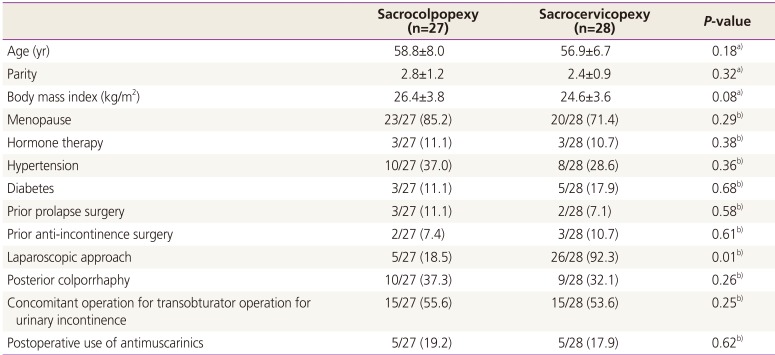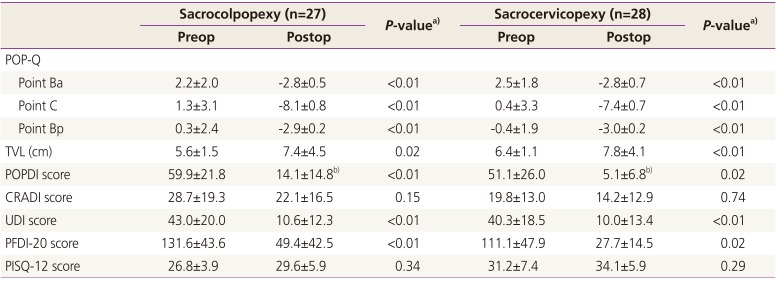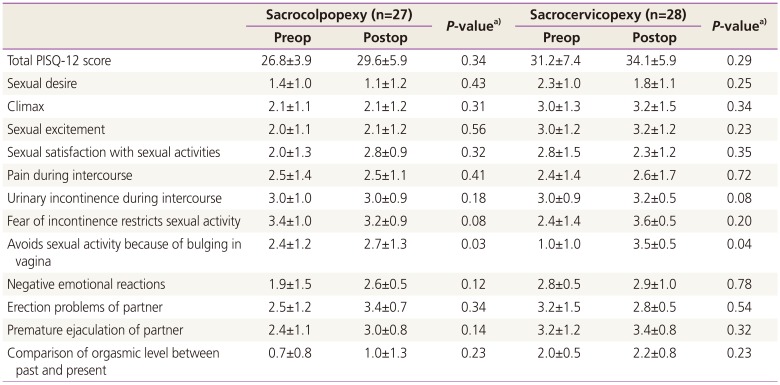1. Smith FJ, Holman CD, Moorin RE, Tsokos N. Lifetime risk of undergoing surgery for pelvic organ prolapse. Obstet Gynecol. 2010; 116:1096–1100. PMID:
20966694.

2. Handa VL, Cundiff G, Chang HH, Helzlsouer KJ. Female sexual function and pelvic floor disorders. Obstet Gynecol. 2008; 111:1045–1052. PMID:
18448734.

3. Fashokun TB, Harvie HS, Schimpf MO, Olivera CK, Epstein LB, Jean-Michel M, et al. Sexual activity and function in women with and without pelvic floor disorders. Int Urogynecol J. 2013; 24:91–97. PMID:
22744621.

4. Shah SM, Bukkapatnam R, Rodriguez LV. Impact of vaginal surgery for stress urinary incontinence on female sexual function: is the use of polypropylene mesh detrimental? Urology. 2005; 65:270–274. PMID:
15708036.

5. Pauls RN, Silva WA, Rooney CM, Siddighi S, Kleeman SD, Dryfhout V, et al. Sexual function after vaginal surgery for pelvic organ prolapse and urinary incontinence. Am J Obstet Gynecol. 2007; 197:622. PMID:
18060954.

6. Handa VL, Zyczynski HM, Brubaker L, Nygaard I, Janz NK, Richter HE, et al. Sexual function before and after sacrocolpopexy for pelvic organ prolapse. Am J Obstet Gynecol. 2007; 197:629. PMID:
18060957.

7. Azar M, Noohi S, Radfar S, Radfar MH. Sexual function in women after surgery for pelvic organ prolapse. Int Urogynecol J Pelvic Floor Dysfunct. 2008; 19:53–57. PMID:
17571198.

8. Altman D, Elmer C, Kiilholma P, Kinne I, Tegerstedt G, Falconer C, et al. Sexual dysfunction after trocar-guided transvaginal mesh repair of pelvic organ prolapse. Obstet Gynecol. 2009; 113:127–133. PMID:
19104368.

9. Peterson ZD, Rothenberg JM, Bilbrey S, Heiman JR. Sexual functioning following elective hysterectomy: the role of surgical and psychosocial variables. J Sex Res. 2010; 47:513–527. PMID:
19705325.

10. Serati M, Salvatore S, Uccella S, Laterza RM, Cromi A, Ghezzi F, et al. Sexual function after radical hysterectomy for early-stage cervical cancer: is there a difference between laparoscopy and laparotomy? J Sex Med. 2009; 6:2516–2522. PMID:
19549091.

11. Yoo EH, Jeon MJ, Ahn KH, Bai SW. Translation and linguistic validation of Korean version of short form of pelvic floor distress inventory-20, pelvic floor impact questionnaire-7. Obstet Gynecol Sci. 2013; 56:330–332. PMID:
24328023.

12. Yoo EH, Jeon MJ, Ahn KH, Bai SW. Translation and linguistic validation of Korean version of shortform of PISQ (pelvic organ prolapse and incontinence sexual questionnaire). Korean J Urogynecol. 2012; 14:42–47.
13. Rogers RG, Coates KW, Kammerer-Doak D, Khalsa S, Qualls C. A short form of the Pelvic Organ Prolapse/Urinary Incontinence Sexual Questionnaire (PISQ-12). Int Urogynecol J Pelvic Floor Dysfunct. 2003; 14:164–168. PMID:
12955337.

14. Aschkenazi SO, Botros SM, Beaumont J, Miller JJ, Gamble T, Sand PK, et al. Use of the short pelvic organ prolapse/urinary incontinence sexual questionnaire for female sexual dysfunction in a general population. Obstet Gynecol. 2008; 111:10S.
15. Handa VL, Cundiff G, Chang HH, Helzlsouer KJ. Female sexual function and pelvic floor disorders. Obstet Gynecol. 2008; 111:1045–1052. PMID:
18448734.

16. Lukacz ES, Whitcomb EL, Lawrence JM, Nager CW, Contreras R, Luber KM. Are sexual activity and satisfaction affected by pelvic floor disorders? Analysis of a community-based survey. Am J Obstet Gynecol. 2007; 197:88. PMID:
17618771.

17. Hasson HM. Cervical removal at hysterectomy for benign disease: risks and benefits. J Reprod Med. 1993; 38:781–790. PMID:
8263867.
18. Thakar R, Sultan AH. Hysterectomy and pelvic organ dysfunction. Best Pract Res Clin Obstet Gynaecol. 2005; 19:403–418. PMID:
15985255.

19. Paraiso MF, Barber MD, Muir TW, Walters MD. Rectocele repair: a randomized trial of three surgical techniques including graft augmentation. Am J Obstet Gynecol. 2006; 195:1762–1771. PMID:
17132479.








 PDF
PDF ePub
ePub Citation
Citation Print
Print



 XML Download
XML Download